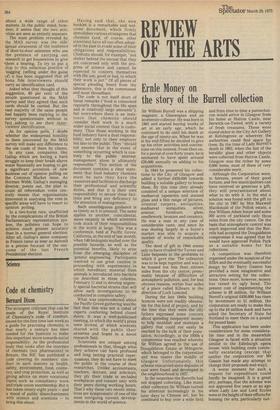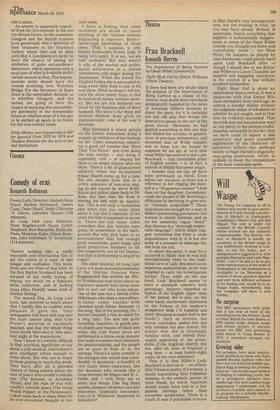REVIEW OF THE ARTS
Ernie Money on the story of the Burrell collection
Sir William Burrell was a shipping magnate, a Glaswegian and an inveterate collector. He was born in 1861 and started buying works of art at an early age, ,which he continued to do until his death at the age of ninety-six. When he was in his mid-fifties he decided to give up his other activities and concentrate on this interest. From then on, for a period of over forty years, he is estimated to have spent around £20,000 annually on adding to his acquisitions.
In 1944 he presented his collections to the City of Glasgow and added a further £450,000 towards building a suitable gallery to house these. By this time they already consisted of a unique selection of mediaeval tapestries and stained glass and a fine range of pictures, oriental carpets, antiquities, mediaeval antiquities, silver,
armour, furniture, glass, needlework, bronzes and ceramics. He was a man in any case of considerable taste, and since he was dealing largely in a buyer's market was able to acquire a number of works of remarkable. quality.
The deed of gift in 1944 seems only to have rivalled the Turner and Lane bequests in the problems to which it gave rise. The collection was to be kept together and was to be housed not less than sixteen miles from the city centre, presumably because of difficulties of atmospheric pollution, and, for less obvious reasons, within four miles of a place called Killearn in the direction of Loch Lomond.
During the late 1940s building licences were not readily obtainable for this kind of project, and by the time that they were the city fathers expressed some concern about spending ratepayers' money to help establish and maintain a gallery that could not easily be reached by the bulk of their population. Accordingly, in the 1950s a compromise was reached whereby Sir William agreed to the use of Dougaldston Estate at Milngavie, which belonged to the corporation and was nearer the middle of Glasgow. Unfortunately, this scheme miscarried since deposits of coal were found and developed in the neighbourhood in 1957.
In the meantime the Burrells had not stopped collecting. Like many other collectors Sir William turned his attention increasingly in his later days to Chinese art, but he continued to buy over a wide field and from time to time a pantechnicon would arrive in Glasgow from his home at Hutton Castle, near Berwick-on-Tweed, with a variety of fresh treasures. These were stored either in the City Art Gallery at Kelvingrove or wherever the authorities could find space for them. By the time of Lady Burrell's death in 1962, when the last of the heraldic glass and other objects were collected from Hutton Castle, Glasgow was the richer by some 8,000 items, most of them of very considerable merit.
Although the Corporation were, in fairness, aware of their good fortune, and few municipalities can have received so generous a gift, they still procrastinated about what to do with it. In the end a solution was found with the gift to the city in 1967 by Mrs Maxwell Macdonald of the Pollok estate, a fine William Adam house and some 360 acres of parkland only three miles from the city centre. On the basis that atmospheric control was much improved and that the Burrells had accepted the Dougaldston compromise it was agreed that he would have approved Pollok Park as a suitable home for his collections.
A competition was therefore organised under the auspices of the RIBA and the eventually successful design by Mr Barry Gasson has provided a most imaginative and attractive setting for the collections. Once more, however, money has raised its ugly head. The present cost of implementing the scheme is £8 million. Sir William Burrell's original £450,000 has risen by investment to El million, the corporation are ready to make this up to the £4 million mark and have asked the Secretary of State for Scotland to meet them on a pound for pound basis.
This application has been under consideration for some considerable time and in the meanwhile Glasgow is faced with a situation similar to the Edinburgh opera house, with building costs continually escalating (except that neither the corporation nor Mr Gasson has made any attempt to change their proposals mid-way).
A worse moment for such a request for expenditure could hardly be imagined. It is a great pity, perhaps, that the scheme was not approved five years or so ago when Lady Lee and Lord Eccles were at the height of their efforts for housing the arts, particularly out side London.
An answer is apparently expected from the Government in the not too distant future. In the meantime Glasgow and the Bun-ell trustees have generously lent a selection of their treasures to the Hayward Gallery where they can be seen until May 4. Londoners are lucky to have the chance of seeing an exhibition of quite extraordinary distinction, which represents only a small part of what is available and in certain sectors at that. The Impressionists alone should have the crowds scurrying over Waterloo Bridge. For the Secretary of State there is the unenviable decision as to whether Glasgow, and the nation, are going to have the chance of enjoying this extraordinary patrimony in the foreseeable future or whether most of it has got to be packed up again in its boxes for the next twenty years.
Entle Money was Conservative MP for Ipswich from 1970 to 1974 and Shadow Minister for the Arts in the last Parliament



































 Previous page
Previous page